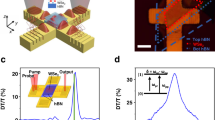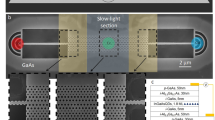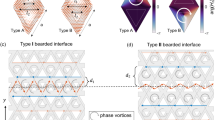Abstract
The ability to slow down the propagation of light touches both fundamental aspects of light–matter interactions and practical applications in photonic communication and computation1,2,3. Optical quantum interference can substantially reduce the speed of light while offering additional dramatic optical effects based on the ability to control electronic quantum states4,5. Recent efforts are increasingly being directed towards harnessing these effects in integrated photonic structures6,7. Here, we report the first demonstration of slow light and electromagnetically induced transparency in a self-contained, planar atomic spectroscopy chip. Using hot rubidium atoms in hollow-core waveguides, we demonstrate 44% optical transparency with a group index of 1,200, or more than sevenfold slower light than in photonic-crystal waveguides8. Optical pulse delays of 16 ns with a delay-bandwidth product of 0.8 are observed. This implementation of atomic quantum state control in integrated photonic structures will enable coherent photonics at ultralow power levels.
This is a preview of subscription content, access via your institution
Access options
Subscribe to this journal
Receive 12 print issues and online access
$209.00 per year
only $17.42 per issue
Buy this article
- Purchase on Springer Link
- Instant access to full article PDF
Prices may be subject to local taxes which are calculated during checkout




Similar content being viewed by others
References
Hau, L. V., Harris, S. E., Dutton, Z. & Behroozi, C. H. Light speed reduction to 17 metres per second in an ultracold atomic gas. Nature 397, 594–598 (1999).
Bigelow, M. S., Lepeshkin, N. N. & Boyd, R. W. Superluminal and slow light propagation in a room-temperature solid. Science 301, 200–202 (2003).
Van der Wal, C. et al. Atomic memory for correlated photon states. Science 301, 196–200 (2003).
Lukin, M. D. Colloquium: trapping and manipulating photon states in atomic ensembles. Rev. Mod. Phys. 75, 457–472 (2003).
Schmidt, H. & Imamoǧlu, A. Giant Kerr nonlinearities using electromagnetically induced transparency. Opt. Lett. 21, 1936–1938 (1996).
Londero, P., Venkataraman, V., Bhagwat, A. R., Slepkov, A. D. & Gaeta, A. L. Ultralow-power four-wave mixing with Rb in a hollow-core photonic band-gap fiber. Phys. Rev. Lett. 103, 043602 (2009).
Bajcsy, M. et al. Efficient all-optical switching using slow light within a hollow fiber. Phys. Rev. Lett. 102, 203902 (2009).
Notomi, M., Kuramochi, E. & Tanabe, T. Large-scale arrays of ultrahigh-Q coupled nanocavities. Nature Photon. 2, 741–747 (2008).
Kasapi, A., Jain, M., Yin, G. Y. & Harris, S. E. Electromagnetically induced transparency: propagation dynamics. Phys. Rev. Lett. 74, 2447–2450 (1995).
Camacho, R. M., Pack, M. V. & Howell, J. C. Wide-bandwidth, tunable, multiple-pulse-width optical delays using slow light in cesium vapor. Phys. Rev. Lett. 98, 153601 (2007).
Baba, T. Slow light in photonic crystals. Nature Photon. 2, 465–473 (2008).
Vlasov, Y. A., O'Boyle, M., Hamann, H. F. & McNab, S. J. Active control of slow light on a chip with photonic crystal waveguides. Nature 438, 65–69 (2005).
Xia, F., Sekaric, L. & Vlasov, Y. Ultracompact optical buffers on a silicon chip. Nature Photon. 1, 65–71 (2007).
Okawachi, Y. et al. Tunable all-optical delays via Brillouin slow light in an optical fiber. Phys. Rev. Lett. 94, 153902 (2005).
Field, J. E., Hahn, K. H. & Harris, S. E. Observation of electromagnetically induced transparency in collisionally broadened lead vapor. Phys. Rev. Lett. 67, 3062–3065 (1991).
Harris, S. E. Lasers without inversion: interference of lifetime-broadened resonances. Phys. Rev. Lett. 62, 1033–1036 (1989).
Harris, S. E. & Yamamoto, Y. Photon switching by quantum interference. Phys. Rev. Lett. 81, 3611–3614 (1998).
Schmidt, H., Campman, K. L., Gossard, A. C. & Imamoǧlu, A. Tunneling induced transparency: Fano interference in intersubband transitions. Appl. Phys. Lett. 70, 3455–3457 (1997).
Faist, J., Capasso, F., Sirtori, C., West, K. & Pfeiffer, L. Controlling the sign of quantum interference by tunneling from quantum wells. Nature 390, 589–591 (2005).
Turukhin, A. V. et al. Observation of ultraslow and stored light pulses in a solid. Phys. Rev. Lett. 88, 023602 (2002).
Ghosh, S., Sharping, J. E., Ouzounov, D. G. & Gaeta, A. L. Resonant optical interactions with molecules confined in photonic band-gap fibers. Phys. Rev. Lett. 94, 093902 (2005).
Light, P. S., Benabid, F., Couny, F., Maric, M. & Luiten, A. N. Electromagnetically induced transparency in Rb-filled coated hollow-core photonic crystal fiber. Opt. Lett. 32, 1323–1325 (2007).
Ghosh, S. et al. Low-light-level optical interactions with Rubidium vapor in a photonic band-gap fiber. Phys. Rev. Lett. 97, 023603 (2006).
Yin, D., Barber, J., Hawkins, A. R., Deamer, D. W. & Schmidt, H. Integrated optical waveguides with liquid cores. Appl. Phys. Lett. 85, 3477–3479 (2004).
Yang, W. et al. Atomic spectroscopy on a chip. Nature Photon. 1, 331–335 (2007).
Vanier, J. Atomic clocks based on coherent population trapping: a review. Appl. Phys. B 81, 421–442 (2005).
Slepkov, A. D., Bhagwat, A. R., Venkataraman, V., Londero, P. & Gaeta, A. L. Generation of large alkali vapor densities inside bare hollow-core photonic band-gap fibers. Opt. Express 16, 18976–18983 (2008).
Li, Y. & Xiao, M. Electromagnetically induced transparency in a three-level Λ-type system in rubidium atoms. Phys. Rev. A 51, 2703–2706 (1994).
Schmidt, H. & Hawkins, A. R. Electromagnetically induced transparency in alkali atoms integrated on a semiconductor chip. Appl. Phys. Lett. 86, 032106 (2005).
Lunt, E. J. et al. Hollow ARROW waveguides on self-aligned pedestals for improved geometry and transmission. IEEE Photon. Technol. Lett. 22, 1147–1149 (2010).
Acknowledgements
We thank A. Gaeta, S.E. Harris, J. Lowell, S. Knappe and J. Kitching for helpful discussions. We acknowledge support through the nanocharacterization lab in the W.M. Keck Center for Nanoscale Optofluidics at University of California Santa Cruz and financial support by the Defense Advanced Research Projects Agency (DARPA) Defense Sciences Office Slow-Light Program (Air Force Office of Scientific Research contract #FA9550-05-1-0432) and the National Science Foundation under grants ECS-0500602 and ECS-0500670.
Author information
Authors and Affiliations
Contributions
B.W., J.F.H., A.R.H. and H.S. conceived and designed the experiments. J.F.H., K.H. and E.J.L. fabricated the atomic spectroscopy chips. B.W. performed the atomic spectroscopy experiments. B.W. and H.S. analysed the spectroscopy data, and H.S., A.R.H., B.W. and J.F.H. prepared the manuscript.
Corresponding author
Ethics declarations
Competing interests
The authors declare no competing financial interests.
Supplementary information
Rights and permissions
About this article
Cite this article
Wu, B., Hulbert, J., Lunt, E. et al. Slow light on a chip via atomic quantum state control. Nature Photon 4, 776–779 (2010). https://doi.org/10.1038/nphoton.2010.211
Received:
Accepted:
Published:
Issue Date:
DOI: https://doi.org/10.1038/nphoton.2010.211
This article is cited by
-
Phase-controlled asymmetric optomechanical entanglement against optical backscattering
Science China Physics, Mechanics & Astronomy (2023)
-
Coherent interaction of atoms with a beam of light confined in a light cage
Light: Science & Applications (2021)
-
Electromagnetically induced transparency at a chiral exceptional point
Nature Physics (2020)
-
Strong coupling and high-contrast all-optical modulation in atomic cladding waveguides
Nature Communications (2017)
-
Birefringence and polarization rotator induced by electromagnetically induced transparency in rare earth ion-doped crystals
Applied Physics B (2016)



